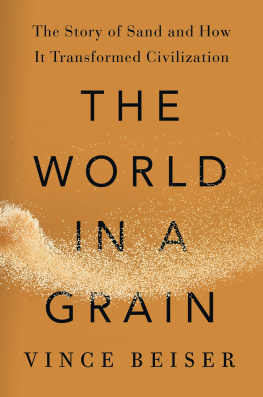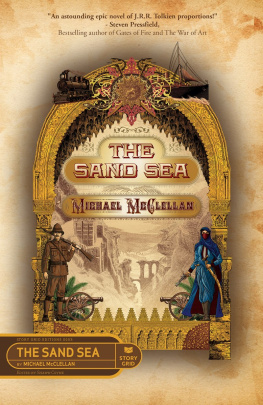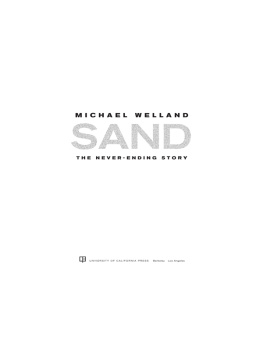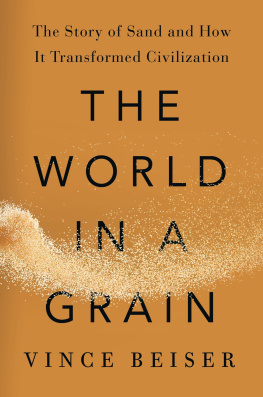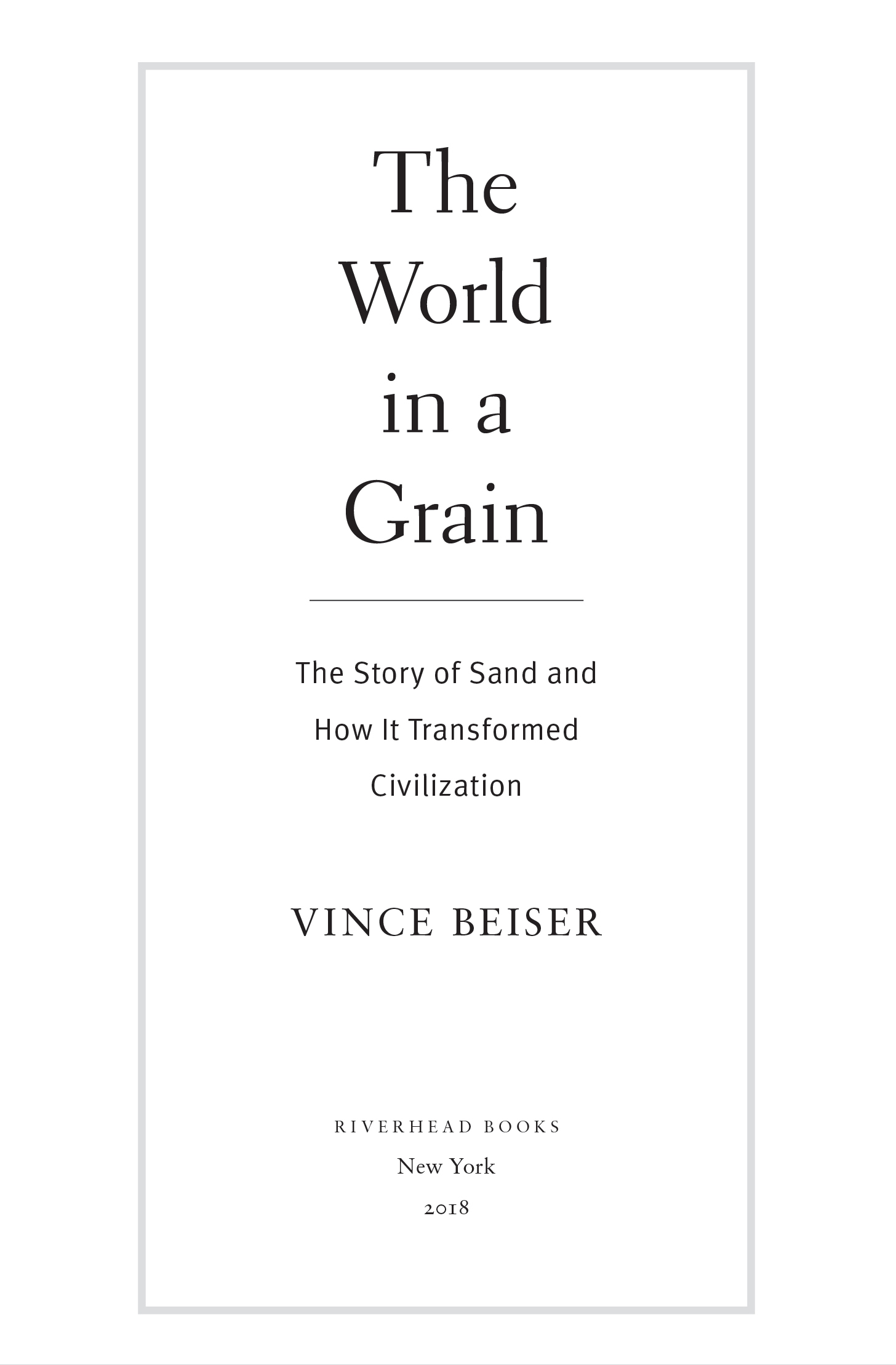Penguin supports copyright. Copyright fuels creativity, encourages diverse voices, promotes free speech, and creates a vibrant culture. Thank you for buying an authorized edition of this book and for complying with copyright laws by not reproducing, scanning, or distributing any part of it in any form without permission. You are supporting writers and allowing Penguin to continue to publish books for every reader.
Names: Beiser, Vince, author.
Title: The world in a grain : the story of sand and how it transformed civilization / Vince Beiser.
Description: New York : Riverhead Books, 2018. | Includes bibliographical references and index.
Identifiers: LCCN 2017053122| ISBN 9780399576423 (hardcover) | ISBN 9780399576430 (ebook)
Subjects: LCSH: Sand. | Technology and civilization.
p. cm.
For Kaile, Adara, and Isaiah. I love you more than there are grains of sand in the whole wide world.
CHAPTER 1
The Most Important Solid Substance on Earth
This book is about something most of us barely ever think about and yet cant live without. It is about the most important solid substance on Earth, the literal foundation of modern civilization.
It is about sand.
Sand? Why is this humblest of materials, something that seems as trivial as it is ubiquitous, so significant?
Because sand is the main material that modern cities are made of. It is to cities what flour is to bread, what cells are to our bodies: the invisible but fundamental ingredient that makes up the bulk of the built environment in which most of us live.
Sand is at the core of our daily lives. Look around you right now. Is there a floor beneath you, walls around, a roof overhead? Chances are excellent they are made at least partly out of concrete. And what is concrete? Its essentially just sand and gravel glued together with cement.
Take a glance out the window. All those other buildings you see are also made from sand. So is the glass in that window. So are the miles of asphalt roads that connect all those buildings. So are the silicon chips that are the brains of your laptop and smartphone. If youre in downtown San Francisco, in lakefront Chicago, or at Hong Kongs international airport, the very ground beneath you is likely artificial, manufactured with sand dredged up from underwater. We humans bind together countless trillions of grains of sand to build towering structures, and we break apart the molecules of individual grains to make tiny computer chips.
Some of Americas greatest fortunes were built on sand. Henry J. Kaiser, one of the wealthiest and most powerful industrialists of twentieth-century America, got his start selling sand and gravel to road builders in the Pacific Northwest. Henry Crown, a billionaire who once owned the Empire State Building, began his own empire with sand dredged from Lake Michigan that he sold to developers building Chicagos skyscrapers. Today the construction industry worldwide consumes some $130 billion worth of sand each year.
Sand lies deep in our cultural consciousness. It suffuses our language. We draw lines in it, build castles in it, hide our heads in it. In medieval Europe (and a classic Metallica song), the Sandman helped ease us into sleep. In our modern mythologies, the Sandman is a DC superhero and a Marvel supervillain. In the creation myths of indigenous cultures from West Africa to North America, sand is portrayed as the element that gives birth to the land. Buddhist monks and Navajo artisans have painted with it for centuries. Like sands through the hourglass, so are the days of our lives, intone the opening credits of a classic American soap opera. William Blake encouraged us to see a world in a grain of sand. Percy Bysshe Shelley reminded us that even the mightiest of kings end up dead and forgotten, while around them only the lone and level sands stretch far away. Sand is both minuscule and infinite, a means of measurement and a substance beyond measuring.
Sand has been important to us for centuries, even millennia. People have used it for construction since at least the time of the ancient Egyptians. In the fifteenth century, an Italian artisan figured out how to turn sand into fully transparent glass, which made possible the microscopes, telescopes, and other technologies that helped drive the Renaissances scientific revolution.
But it was only with the advent of the modern industrialized world, in the decades just before and after the turn of the twentieth century, that people really began to harness the full potential of sand and begin making use of it on a colossal scale. It was during this period that sand went from being a resource used for widespread but artisanal purposes to becoming the essential building block of civilization, the key material used to create mass-manufactured structures and products demanded by a fast-growing population.
At the dawn of the twentieth century, almost all of the worlds large structuresapartment blocks, office buildings, churches, palaces, fortresseswere made with stone, brick, clay, or wood. The tallest buildings on Earth stood fewer than ten stories high. Roads were mostly paved with broken stone, or more likely, not paved at all. Glass in the form of windows or tableware was a relatively rare and expensive luxury. The mass manufacture and deployment of concrete and glass changed all that, reshaping how and where people lived in the industrialized world.
Then in the years leading up to the twenty-first century, the use of sand expanded tremendously again, to fill needs both old and unprecedented. Concrete and glass began rapidly expanding their dominion from wealthy Western nations to the entire world. At roughly the same time, digital technology, powered by silicon chips and other sophisticated hardware made with sand, began reshaping the global economy in ways gargantuan and quotidian.
Today, your life depends on sand. You may not realize it, but sand is there, making the way you live possible, in almost every minute of your day. We live in it, travel on it, communicate with it, surround ourselves with it.
Wherever you woke up this morning, chances are good it was in a building made at least partly out of sand. Even if the walls are made of brick or wood, the foundation is most likely concrete. Maybe its also plastered with stucco, which is mostly sand. The paint on your walls likely contains finely ground silica sand to make it more durable, and may include other forms of high-purity sands to increase its brightness, oil absorption, and color consistency.

